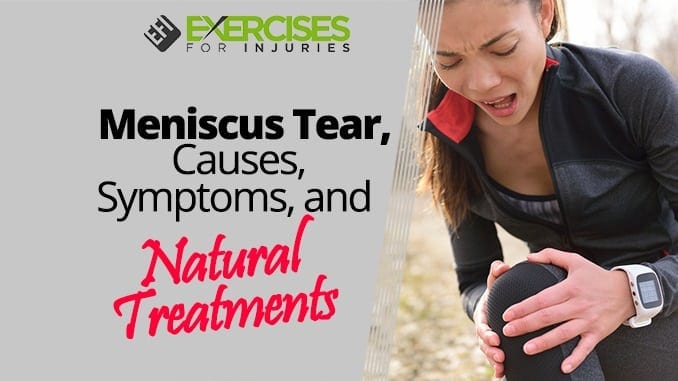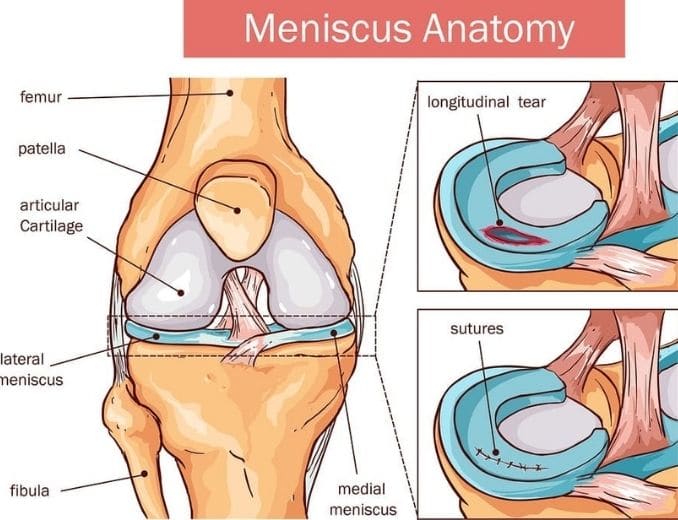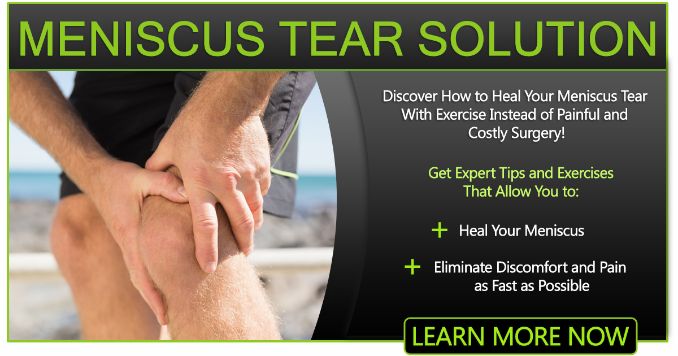
You feel a sudden pop or your knee locks. How do you know if it’s a torn meniscus? This is one of the most common types of knee injury. Even before you go to the doctor, some signs and symptoms can tell you if there is a meniscus tear. Plus, natural treatments may help you even more than surgery. Let’s find out more about Meniscus Tear Causes and Natural Treatments.
Meniscus Anatomy 101
The word meniscus means “crescent” in Greek. This makes sense because the menisci (plural for meniscus) are two C-shaped wedges of cartilage in your knee. They serve as joint cushions and stabilizers, and they facilitate smooth knee joint movement. You have a meniscus located in the middle (medial) and outside (lateral) part of each knee.
The image above shows the relationship between the meniscus and the bones around your knee. The femur is your thighbone, and the patella is your kneecap. Later, we’ll discuss the different types of meniscus damage that can occur.
Super Shock Absorber
Your menisci are incredibly tough and resilient. For instance, when you run, the impact of about five times your body weight compresses your meniscus with each stride. A 6-minute mile takes an average of 1,064 steps to complete. That’s a total of 2,660 times your body weight pounding down on each meniscus after running a mile. Even just the 5,000 to 7,000 steps per day of the average adult takes its toll on your menisci.
What Causes Meniscus Tears?
There are several different ways you can tear your meniscus. For most sports-related injuries, the damage occurs when you squat or twist the knee. Any kind of knee impact may also result in a meniscus tear. A very common situation causing meniscus tears is when you pivot while running. If you get tackled at the same time, the chance of damage is even higher.
Moreover, as you age, your menisci lose their elasticity and thickness. This means they can get torn much easier. Even just a small misstep or rising out of a chair can cause a meniscus tear in older adults.
What Are the Symptoms Of Meniscus Tear?
The symptoms of a Meniscus Tear, Causes, and Natural Treatments depend on the severity of the injury and your age. For example, after a high-velocity sports injury, you might feel a pop and some pain. Still, many athletes keep playing after a meniscus tear if no other damage has been done to the knee.
For older adults, you might not even remember injuring your knee. Plus, a small tear can get gradually worse in time.
In general, there are three different levels of meniscus tear:
1. Mild
Minor pain and/or swelling. Symptoms may disappear after two or three weeks.
2. Moderate
You have pain on one side of the knee. Swelling appears and can worsen over time. Pressure or knee stiffness is common. You might feel sharp pain with certain movements like squatting or twisting. Symptoms may disappear after a few weeks but can linger on and off until you get treatment.
3. Severe
Torn pieces of the meniscus can get stuck in your knee joint. This may cause your knee to lock or pop. You might also feel joint instability or your knee can even collapse without warning.
If you push along the side of your knee where the bones meet (an area called the “joint line”) and it hurts, this could be the sign of a meniscus tear.
How Is A Meniscus Tear Diagnosed?
If you injure your knee and have the symptoms we described, there’s a pretty good chance your meniscus is torn. Still, to be 100 percent sure, you should see a joint specialist. After asking you about your injury, the doctor will examine your knee. Currently, the best way to diagnose a torn meniscus is by having an MRI scan.
Meniscus Tear Treatment
The kind of treatment depends a lot on the location and severity of the tear. The outer edge of each meniscus has a rich blood supply. The chances of healing are better for tears in those areas. The deeper the tear, the less chance there is for spontaneous healing.
Other factors to consider in Meniscus Tear Causes and Natural Treatments are symptom severity, activity level, and age. For instance, if you are a highly competitive athlete, you’ll probably want a faster more aggressive treatment. The average adult, however, may be willing to take their time to avoid risks such as surgery.
Now, let’s look at the different stages of treatment.
Immediately After Injury
When you have a knee injury, the first thing you should do is put ice on it and elevate the knee. Don’t apply ice directly to the skin. Instead, wrap a damp towel around the knee then put a bag of ice on the towel. This drops the temperature of the knee without the risk of damaging your skin. Ice your knee for about 20 minutes every 4 to 6 hours for the first 24 hours after injury.
Depending on how bad the injury was, you might want to see a physician right away. Other things like fractures or ligament damage might have occurred. You don’t want to delay proper treatment. Just because you can walk on it doesn’t mean there are no broken bones.
Physical Therapy
After you’ve been diagnosed with a meniscus tear, your doctor might recommend physical therapy. The goal of therapy is to restore as much function as possible with a minimal amount of pain.
Some modalities used in meniscus tear rehab include:
- Muscle strengthening
- Balance and range of motion exercises
- Heat and/or ice
- Joint compression
- Neuromuscular electrical stimulation (NMES) — gently stimulates muscles to strengthen them
Your physical therapist will also give you exercises to do at home to continue the healing and strengthening process.
Nutritional Tactics for Meniscus Repair
While there are no major studies about food and meniscus recovery, we can draw some general conclusions about how our bodies work to repair any damage. One of the main reasons an injury may take longer to heal is inflammation. Instead of taking anti-inflammatory medications, an anti-inflammatory diet might help speed up healing naturally.
The key components of an anti-inflammatory diet are antioxidants, minerals, and also essential fatty acids.
The following foods are powerhouses when it comes to fighting inflammation:
1. Swiss Chard
This green leafy vegetable contains an unusually high nutritional density. Packed with omega-3 and omega-6 fatty acids as well as vitamins A, K and C. Also contains magnesium, manganese, and potassium. Indeed great for salads.
2. Pineapple
Contains bromelain, which modulates the immune response and inflammation. Also rich in vitamin C, vitamin B1, potassium, manganese, and other antioxidants.
3. Salmon
Has huge amounts of omega-3 fatty acids. Also dense in B vitamins, vitamin D and selenium. The extra protein may also speed up healing.
4. Broccoli
One of the healthiest foods on the planet. Delivers anti-inflammatory vitamins, minerals, flavonoids, and carotenoids.
Glucosamine And Chondroitin
If you hurt your knee, a meniscus tear might be part of a larger problem. For example, as you age, the knee anatomy changes and cartilage gets thinner. Plus, you might have other changes that eventually lead to degenerative joint disease (“arthritis”). This means any injury should be treated in the overall context of joint health.
Moreover, the Glucosamine Chondroitin Arthritis Intervention Trial (GAIT) found that the combination of glucosamine and chondroitin sulfate used for eight weeks gave significant relief to the majority of study participants with high amounts of joint pain. Glucosamine and chondroitin are not miracle drugs, and they are not recommended specifically for a meniscus tear. However, in the process of recovery, these supplements might be useful to regain your knee function.
Should I Have Surgery?
In the past, it was very common to have meniscus surgery to fix a tear. The idea was to snip off the torn cartilage so it wouldn’t bother you anymore. However, recent medical studies show that physical therapy works just as well as surgery. Plus, meniscus surgery also increases your chances of needing a knee replacement in the future.
One study even showed that sham surgery was just as effective as real surgery. The study had one group of people also undergo actual meniscus repair surgery. The other group only had their skin cut to make it look like they had surgery. Both groups had similar long-term outcomes, meaning that meniscus surgery may indeed not do much at all.
At this time, the current advice is to have surgery only for very severe tears that may happen in competitive sports. People who have severe pain with no relief from other treatments might also consider surgical options.
Conclusion
If you hurt your knee or it pops or gives, and have a Meniscus Tear causes and need Natural Treatments, see your doctor. Then implement all your energy and knowledge to regain knee function. A little know-how, patience, and persistence should get you back on track after.
If you want to repair your meniscus tear and eliminate discomfort and pain as fast as possible, then check out the Meniscus Tear Solution program, here!





